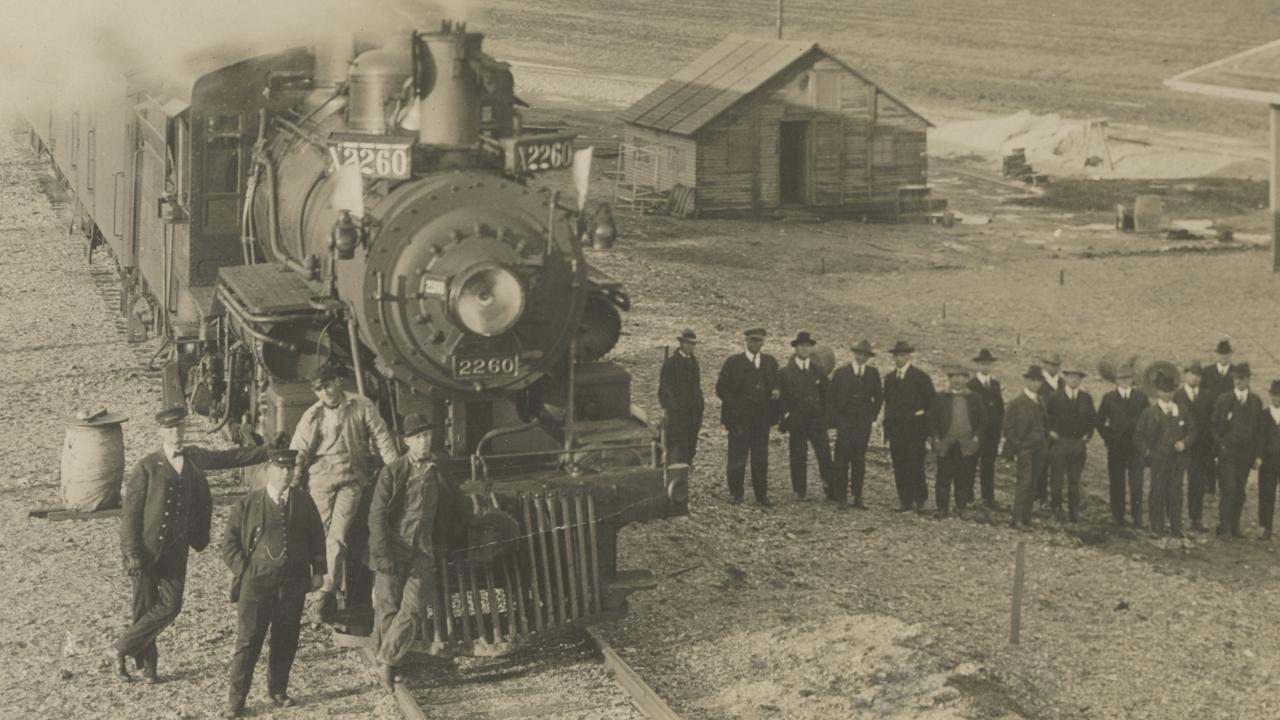Lunchable is a regular feature of the UC Davis Arts Blog that recommends an arts attraction that can be viewed during a lunch or other short break.
Written by Leigh Houck, UC Davis News and Media Relations Intern
UC Davis Library joins in celebrations across the region
While Davis might not be the first place that comes to mind when thinking of the transcontinental railroad, you will get a new impression when you visit the UC Davis Library’s latest exhibition. It is one of many in the region as the 150th anniversary of the railroad happens this year.
When entering the library, veer left toward Special Collections. There, visitors can learn how the railroad influenced the selection of Davis as the home of the University Farm (which became UC Davis), the growth of California agriculture, and the promotion of the state to tourists and settlers.
All Aboard...
All Aboard: Celebrating the 150th Anniversary of the Transcontinental Railroad
April 5- Sept 20, 2019
Peter J. Shields Library, UC Davis
Free
More details here.
The free exhibit commemorating the 150th anniversary of the completion of the transcontinental railroad is curated by Sara Gunasekara, public services and archives specialist, and presented by Special Collections and located outside the Shields Library Special Collections Room.
The 1,912-mile continuous railroad line is often considered the greatest technological feat of the 19th century.
The U-shaped configuration of glass cases contains a chronological retelling of the transcontinental railroad’s conception, construction and history. This story is punctuated with model railroad tracks and cabins. The story begins long before the final golden spike was driven and the railroad service began in 1869, when engineers first set out to determine and report back on the best route for the railroad. The story details the relationship between California agriculture and the railroad before discussing the railroad’s role in bringing both settlers and tourists to the state. The exhibit concludes with a display of mid-century tourism brochures for California a more contemporary photo of the Davis train station in 1993.
Links to immigration and Chinese labor
Visitors of “Documenting the Undocumented,” another exhibit currently on display at the library, will note crossover in the topics of these two exhibitions. Immigration is inextricably linked with the development of the United States, and the transcontinental railroad is no exception; the exhibit notes that Chinese laborers were a crucial part of the railroad construction workforce in the United States.
In addition to historical visuals and documents, the exhibit includes a looped screen projection of a clip from 1936 in which workers pack pears for shipment in the then-revolutionary refrigerated railcars.
American history buffs and train enthusiasts alike will take special interest in this collection that includes everything from old telegraphs to travel guides to an old timeline set out for the completion of the railroad. Collectors and fans of Americana will delight in the prints of old fruit crate labels for lemons and the quaint brochure for the “California Zephyr — The Most Talked About Train in the Country” complete with pictures of the “Vista dome” glass panels for easy viewing of the passing American scenery.
While we are celebrating 150 years of the transcontinental railroad, what would a celebration be without gifts? Visitors to the exhibit can collect several freebies. Bored kids and stressed summer session students can borrow colored pencils and fill in a free railroad themed coloring page. And don’t forget to pick up your free postcard. You can send a photograph of the Davis train station, circa 1944, to any friends who do not have the fortune to visit the surprisingly historical Davis.
Other celebrations
There are other celebrations of the railroad’s anniversary in the region, including at the California State Railroad Museum in Sacramento. The Crocker Art Museum in Sacramento is also running an exhibition: “The Race to Promontory: The Transcontinental Railroad and the American West.” The exhibit can be viewed with the purchase of a general admission ticket to the museum. Other railroad celebrations on the West Coast are listed in this San Jose Mercury News story.
